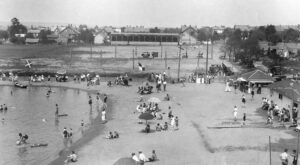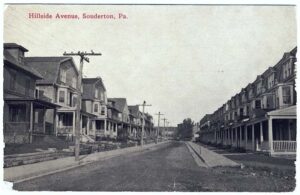Growing up on Hillside Avenue in the 1930s and early ‘40s meant one thing – a wealth of playmates. Summers were made for us; there was always activity on front porches and sidewalks, in back yards, and in the street.
The porch was washed weekly (along with the sidewalk) and it was here where we played War and Fish, tiddlywinks and Uncle Wiggly, jacks and pick-up sticks. Paper dolls were a favorite. We “played house” with our dolls, taking turns being the mother or father and proudly walking our doll coaches down the sidewalk. I still have my coach but Betsy Wetsy and Shirley Temple have sadly disappeared.
The umbrella mender/organ grinder worked on many a front porch each summer, his monkey entertaining us as he plied his trade. The knife sharpener, too, found business here and the local huckster came door to door selling produce. Tramps, on the other hand, came to the back door looking for food; there was always a plate of something to offer. The sidewalk was perfect for roller skating, hop scotch, and jumping rope. One neighborhood rope reached across the entire street, the turners standing on opposite sidewalks. “Mabel, Mabel, set the table…”
In August, the sidewalk was essential for making peach pit necklaces. Directions: take one dry pit, rub ‘til smooth on sidewalk, give to neighborhood dad to shellac and bore hole, thread with black grosgrain ribbon long enough to wear around your neck.
There was basically no traffic to worry about so the street was great for Red Rover, Kick the Can, Mother May I, and Red Light Green Light. A streetlight outside our house provided enough illumination to continue games after dark. Of course there were always lightning bugs to catch.
Waiting for the iceman was a treat. As he uncovered his blocks of ice, we knew we were welcome to the chips that had fallen off. I inherited the family ice pick with “J. Willard Landis” and a three-digit phone number printed on the wooden handle.
An even bigger summer treat was the arrival of the ice cream man each evening. As soon as we heard his bell and the clip-clop of the horse’s hooves, we ran inside to get the 3 cents needed for a cone. And oh, the joy when we were given 5 cents for a big cone on a Friday night! But, as the coal stove and the ice box transitioned to electricity and the family car no longer sported a rumble seat, the horse-drawn wagon evolved to a motor-driven vehicle. (The ice cream tasted just as good.)
The cellars of most houses on our side of the street opened onto a concrete area under the back porch. Ours was enclosed, however, and was known as “the playhouse” in the neighborhood. Along with an assortment of trikes, scooters, hoops, balls, and skates was a dress-up collection. Cast-off adult shoes and clothing provided hours of playing grown-ups. Occasionally we became hula dancers wearing skirts made of iris leaves that lined our fence. On the other hand, making hollyhock dolls from a neighbor’s garden was a punishable offense.

Outdoor weddings were popular even in the ‘30s. Mine was held two yards down from ours with the wedding party appropriately garbed in child-sized outfits. The bride and bridesmaids wore gowns, the bridegroom a sailor suit, and the preacher was donned in a black robe.
The grape arbor in our yard provided pastime as we picked scores of Japanese beetles off the leaves and immersed them in kerosene. My dad and uncle harvested
the grapes and converted them into wine stored in a huge jug in the cellar. There were many samplings until it became potable.
The Honey Creek ran just behind Hillside, its concrete cover extending from Main Street to the other side of Wile Avenue where it opened into “the woods”. It was here that we explored and clambered over slippery rocks. A few brave souls one day walked its length in creepy darkness to the Main Street side where it ended at Happy the Tramp’s lodging.
Every afternoon a gang of us, with the older kids in charge of the younger, trudged up Wile Avenue to the swimming pool. Mr. and Mrs. Williamson taught all of us how to swim, heads above murky water. [The spring-fed source and sandy bottom precluded a need for goggles.] Some of us continued to swim the “Souderton Pool Freestyle” throughout life.

Umbrellas dotted the sandy perimeter and adults enjoyed playing tennis and pitching quoits. There was a bathhouse, a first-aid station, and a refreshment stand. We waited with anticipation as we ate our popsicles, hoping to see a free offer for another popsicle printed on the stick.
I remember the smells of summer with fondness—the neighbors’ honeysuckle behind their garage, hot sidewalks when the first raindrops hit, pitch as the steamroller lumbered down the street, wash drying on the clothesline, and the yeast when my dad made root beer. Smells I don’t treasure were the open garbage truck and Holly’s cheese.
There was no ice cream man in winter, but we did enjoy an occasional ice cream made from snow. There was also that good frozen cream that popped the bottle caps in the West View Dairy milk box on excessively cold nights—the kind of nights when Jack Frost painted intricate scenes on our bedroom windows.
Enough freezing weather transformed our beloved swimming pool into a skating pond. Skates slung over shoulders, up the hill we climbed again. Kids came from all over town to free skate and play Crack the Whip. Pity that poor kid on the end!
An ample snow provided sledding on Holly’s Hill and on the hill behind Chestnut Street School. The playground was a good venue for snowball fights between the Uptowners (Summit Street School) and the Downtowners (Chestnut Street). The smell of wet woolen snow pants and mittens permeated many a home as outerwear dried near hot air registers.

Saturday afternoons were spent at the Broad Theater. What a bargain we got for one thin dime! Movietone News was followed by a cartoon, then a serial—Zorro and The Lone Ranger were popular. After the full-length feature came a short cowboy or mystery film. The 10-cent cost was bumped up to 12 cents with the advent of taxes. Still a good deal.
We loved our radio programs. The Green Hornet, The Lone Ranger, and Little Orphan Annie gave us endless hours of entertainment. The sound effects were wonderful! My sister and I would snuggle under the covers at bed time to be deliciously frightened as we listened to the creaking door of Inner Sanctum or to the laughter of The Shadow. “Who knows what evil lurks in the hearts of men? The Shadow knows.”

And more than 80 years later the few Hillside Sewer Rats who remain still have a good time playing “Do You Remember…”
****
The Souderton-Telford Historical Society seeks to preserve and share the history of our towns, businesses, and residents. Follow us on Facebook (@SoudertonTelfordHistory) and enjoy posts about local history. Do you have old photographs we can scan for our collection? Or a story to share about growing up in the Souderton-Telford area? We would like to hear from you! Email newsletter@soudertontelfordhistory.org.
The Souderton-Telford Historical Society is a 501(c)(3) non-profit. Your contribution helps to collect, preserve, and share the history of our towns. Tax-deductible donations may be mailed to:
Souderton-Telford Historical Society
127 E. Broad St.
Souderton PA 18964
Or use the DONATE button on our Facebook page.
